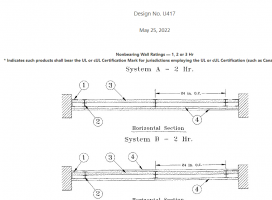Lorenbb
Member
Is this a case when the fire wall between a Type I and a Type V building can include wood framing?
The situation:
Does anyone agree?
The situation:
- We need a 3-hour fire wall between R-2 occupancy Type V and Type I buildings per IBC 706.4.
- Code edition is Washington State 2015 IBC.
- The 3-hour rating is being achieved with two separate 2-hour walls following the double wall approach outlined in IBC 706.2 and NFPA 221-2015 Table 4.5. In this double wall approach, 2-hour walls are located at the opposing faces of each building, and those two walls provide a combined assembly fire-resistance rating of 3-hours.
- This double wall approach contrasts with a conventional fire wall, where the single wall assembly is attached to, and supported by, both buildings. Reasonably, a conventional fire wall must comply with the requirements of both buildings, and because of the Type I building, wood framing would not be allowed.
- In this case, the two 2-hour walls in this are physically separated by a 16” seismic gap between the Type V building and the Type I building. The 2-hour walls are each exclusively located in, and supported by, only one building or the other.
Does anyone agree?

